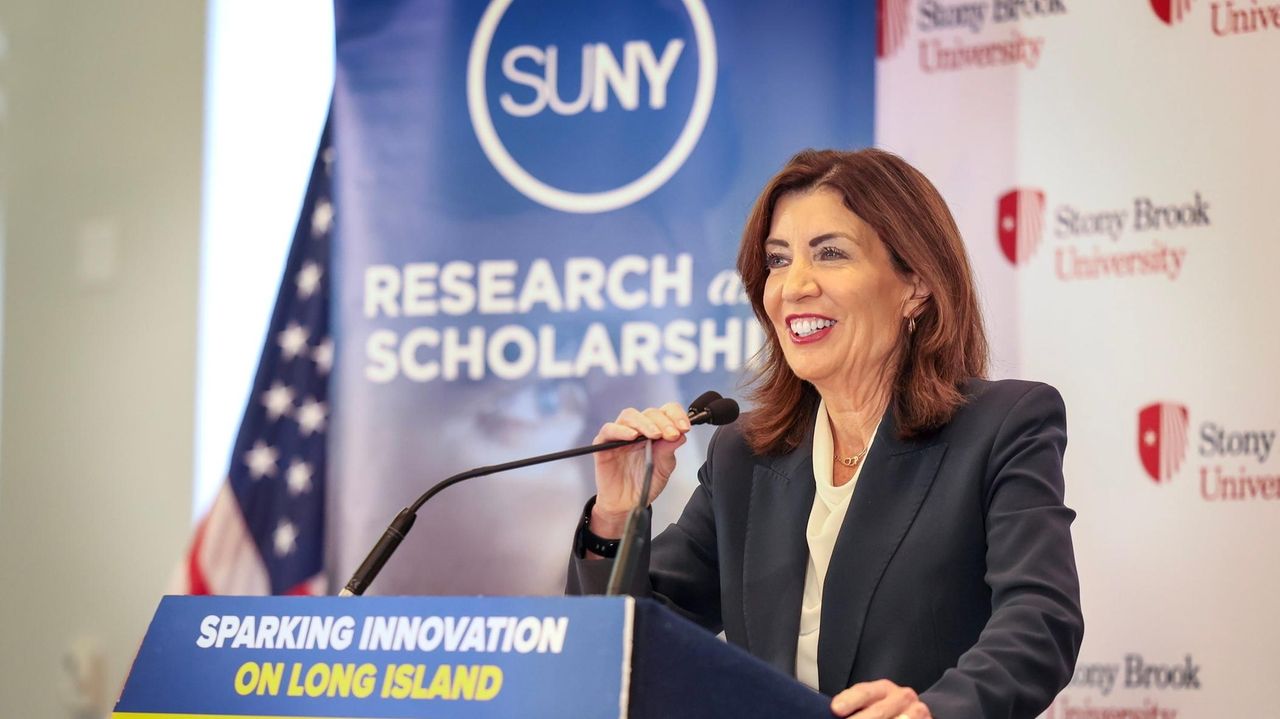Gov. Kathy Hochul announced Wednesday the state is investing $300 million to create a new Quantum Research and Innovation Hub at Stony Brook University, which she said would help make the university “a global powerhouse … recognized globally as the place where the smartest people want to be and the smartest students want to be educated.”
“We’re investing big time today,” Hochul said, speaking at the university’s Center of Excellence in Wireless and Information Technology, or CEWIT.
The expenditure will allow the university to attract top-notch researchers and students, create jobs and help establish Long Island as a major center for quantum computing, university officials said.
The technology has been called a new kind of internet, with vastly more power, data security and speed than the current version. It is expected to transform the way technology is used in national security, finance, health care and other fields.
The investment is “huge news” for Long Island, and it will help advance the region’s plans for a research corridor that connects academic institutions and helps create new start-up companies, said Kevin Law, who chairs the Stony Brook University Council. The state funding, he said, “will help attract the capital and the investments that they need to translate that research into commerce.”
Andrea Goldsmith, the university’s president, called the funding “a truly extraordinary investment in our university that will transform science and technology in the United States and around the world.”
At the news conference, Goldsmith compared the technology’s current form to the state of cellular communication in the 1980s, when she said today’s smart phones would have seemed “magical.”
She said, “We have created that magic here at Stony Brook by building the largest quantum network in the country.”
170-mile network
Stony Brook’s quantum computing network now stretches roughly 170 miles between Stony Brook, Brookhaven National Laboratory and other Long Island locations as well as the Brooklyn Navy Yard, Goldsmith said in an interview before the announcement. The world’s largest network is in China, she said.
The way quantum computing works is very different from the way typical computers currently work, said Eden Figueroa, quantum information technology research leader and presidential innovation endowed professor of physics and astronomy at Stony Brook.
Today, computers generally communicate with each other using millions of pulses of light traveling through fiber optic cables, he said. By contrast, quantum computers are connected through tiny particles that are “entangled” with each other, he said. The particles’ connection has been compared with that of a set of twins who can instantaneously sense each others’ experiences, such as one twin knowing that the other has had a heart attack, he said.
“A little bit metaphysical, right? But this is what entanglement is,” he said. “If you make a measurement of the properties of this one, then you automatically know the property of the other.”
Eden Figueroa in the Quantum Network Control Center at SBU. Credit: Newsday/John Paraskevas
Communicating through those quantum connections is not only faster than sending information through cables, but it also helps make the quantum internet more secure, he said.
That will have implications for national security and for any business that needs to transmit data in a secure way, since quantum computers are powerful enough to break through security measures — including the measures that protect cryptocurrency transactions — and also are much harder to hack into than regular computers, said Kevin Gardner, Stony Brook’s vice president for research and innovation.
Asked whether the quantum internet would relieve computer users from having to remember their online passwords, Gardner laughed.
“I hope so,” he said. Passwords, he said, “are going to be crackable by quantum computers, and so the password to your bank or whatever, all those kinds of things aren’t going to be secure anymore. So there will have to be a new, quantum-based cryptography.”
Maura McDermott covers education. Since joining Newsday in 2012, she also has worked on the investigations team and covered real estate and the business of health care.
